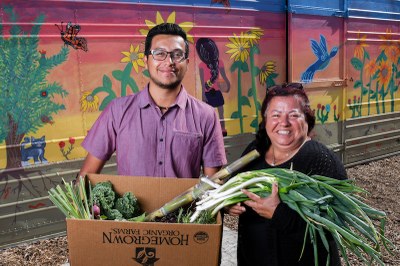How to work with communities

- U.S. Department of Agriculture (USDA) Natural Resources Conservation Service (NRCS) Redlands District Conservationist Tomas Aguilar-Campos and HdV Co-Founder and Executive Director Maria Alonso. (USDA Photo by Lance Cheung)
In this area we hope our community will share resources on how to work effectively and respectfully with diverse communities, from initial outreach and communication to ongoing engagement and partnership. This is especially relevant when working with communities that have different backgrounds, identities, and experiences than the conservation professional.
OneUSDA Intranet
Your one-stop shop for USDA news and tools for work.
Translated Resources for Non-English Speaking Producers - Library on farmers.gov
This new page is searchable and can be filtered by language to better serve staff and producers alike. The library includes publications on conservation, disaster recovery, loans, and other topics, translated into 10 languages, with more to come. This library will grow quickly over the next few months as we begin stocking it with all the translated materials from each FPAC agency.
Post: 11 Lessons We’ve Learned as Equity, Inclusion, and Diversity Consultants in the Outdoor, Conservation, and Environmental Sector
Diversity, equity, and inclusion (or DEI) work seems to be happening throughout the conservation space, but leaders are at times hard pressed to explain why this work is mission-critical beyond “it’s the right thing to do.” And though we agree DEI is the right thing to do, it behooves Blue Sky Funders Forum members to be more specific about why and how DEI work is imperative to the mission of making environmental learning opportunities accessible in all communities.
Article: Meet the scientists embracing traditional Indigenous knowledge
From grizzly bears in areas undocumented by Western science to a possible new fast-running subtype of caribou, traditional knowledge is enriching scientific information about our natural world...
Article: Why communities must be at the heart of conserving wildlife, plants and ecosystems
A little more than a year ago, the Haida Nation released the Land-Sea-People plan to manage Gwaii Haanas, off the coast of northern British Columbia, "from mountaintop to seafloor as a single, interconnected ecosystem." It's an innovative conservation effort that demonstrates how the Haida Nation and Canada's federal government can achieve biodiversity targets, protect the rights of Indigenous people and encourage collaboration among communities, governments and society. And it's an example of what we need more of to meet conservation objectives in the coming decade. The Aichi Targets for biodiversity conservation date back to 2010 and provided nations with the goalposts for the protection of species and habitats. Each of the 194 signatories to the UN Convention on Biological Diversity (CBD) was expected to meet all 20 targets by December 2020—ranging from preventing the extinction of threatened species to expanding protected area coverage. But few of the targets have been adequately met...
Post: Resources for racial justice, anti-racism, and allyship in the outdoors
Post from Conservation Northwest about how to support racial justice, anti-racism, and allyship in the outdoors
Article: Advancing Antiracism, Diversity, Equity, and Inclusion in STEMM Organizations
National Academies of Sciences, Engineering, and Medicine. 2023.
Video: Environmental Justice is About Engaging with Communities on a Personal Level
Short video with Edith Pestana. Part of a series from the EPA featuring federal and local government officials, non-profit leaders, and students, who tell stories about the lessons they have learned over their time working on environmental justice.
Guide: The Spectrum of Public Participation
The Spectrum of Public Participation was created by the International Association for Public Participation (IAP2)—an international professional organization that works to advance the practice of public participation globally. The Spectrum is a useful tool for professionals to consider opportunities to improve and deepen public participation and engagement.
Guide: Making Equity Real in Climate Adaptation and Community Resilience Policies and Programs
A Guidebook from the Greenlining Insitute, a nonprofit founded in 1993, that works to create a nation where communities of color thrive and race is never a barrier to economic opportunity. To prioritize the climate adaptation and community resilience needs of frontline communities and address the historical neglect they have experienced, we must move beyond embracing equity to making it real. This requires centering community needs and building social equity into the very fabric of policies and grant programs that focus on climate adaptation and resilience. To get there, this Guidebook offers policymakers a blueprint on how to operationalize equity in policies and grant programs






















